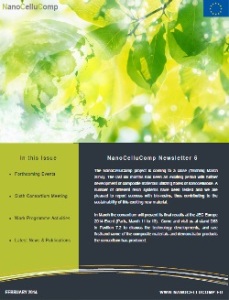Mar 5 2014
Society relies heavily on advanced materials, such as composites, made from non-renewable petroleum-based products that are energy intensive and require significant use of volatile solvents to manufacture.
 NanoCelluComp - development of nanocellulose-based composites for high performance applications. Image Credit: NanoCelluComp.
NanoCelluComp - development of nanocellulose-based composites for high performance applications. Image Credit: NanoCelluComp.
NanoCelluComp has been funded under FP7 (contract no. 263017) to develop novel nanocellulose-based composites for high performance applications. It is developing ways to:
- replace rare or non-renewable (e.g. petroleum based) materials with materials from renewable sources (e.g. bio-based);
- decrease energy consumption;
- decrease use of volatile, hazardous chemicals.
Food processing of vegetables produces billions of tonnes of fibrous waste. The cellulose fibres contained within this waste have superior structural properties that with ‘green’ chemistry can be put to much better use. Composites containing cellulose extracted from carrot waste have already been incorporated in lightweight products such as fishing rods and steering wheels.
This material - Curran - while exhibiting good structural properties, does not have the strength of glass or carbon fibre reinforced plastics (GFRP and CFRP) and is further disadvantaged due to limited processability.
NanoCelluComp has improved on Curran through:
- Liberating microfibrillated cellulose (nanocellulose) from vegetable waste streams utilising an aqueous based process (thus decreasing energy consumption, and avoiding volatile chemicals).
- Improving mechanical properties by the controlled alignment and cross linking of nanocellulose fibrils.
- Combining the resultant fibres with bio-based resins to produce a 100% bio-composite (thus decreasing use of petroleum-based products).
- Ensuring compatibility of the bio-composite with current manufacturing processes (e.g. injection moulding, hand lay-up).
- Investigating the sustainability of the above processes and materials, compared to existing materials, through a full life-cycle assessment (LCA) and identifying promising application fields.
Find out more about this exciting project and meet the partners to discuss how its results can impact your business at JEC Europe 2014, Paris, 11-13 March 2014.
Source: http://www.nano.org.uk/